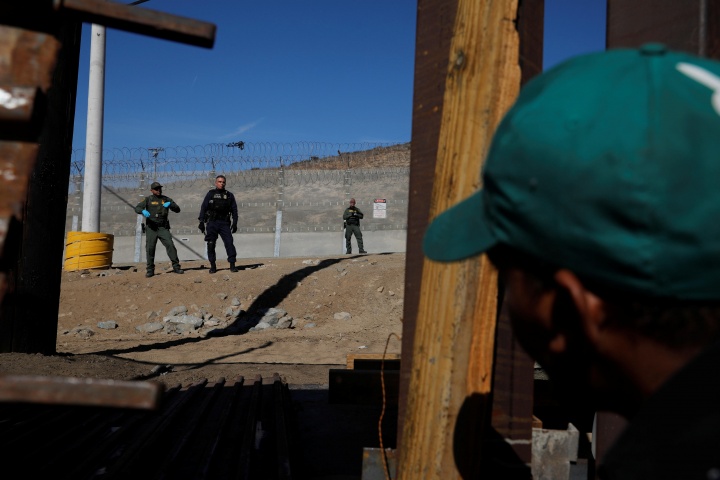For “Scripture Sunday”:
The Illegal Immigration Crisis—No End in Sight
“As debate between those who want secure borders preventing illegal immigration and those who want open borders rages on, the crisis continues to grow.
 Alkis Konstantinidis/Reuters/Newscom
Alkis Konstantinidis/Reuters/Newscom
The immigration issue has stoked the growing fires of division.
Nothing paints the divide of the culture war more starkly than the debate over illegal immigration. People in the United States and many other nations debate this issue continually, ideologically split into one of two camps—those who feel that unrestricted immigration is good for their nation and those concerned that it’s being inundated by waves of people skirting the rules in coming into the country illegally, saddling the nation with enormous and unsustainable costs.
As polarization over the issue increases, so does the rhetoric. U.S. President Donald Trump, whose 2016 election resulted in part from his strong stand on immigration, shocked many with his recent announcement that he is considering an executive order that would end automatic unrestricted “birthright citizenship” for babies born to illegal immigrants on U.S. soil (a practice allowed in fewer than one in five countries around the world).
On the other side, the radical left in America has reacted to strong enforcement actions by the U.S.Immigration and Customs Enforcement (ICE) division of the Department of Homeland Security with calls to abolish it.
The changing face of immigration

For legal immigrants, that process continues. But the past 40 or so years have witnessed millions coming to the United States illegally, bypassing a legal immigration process developed over a long time.
Drawn to a land of peace instead of turmoil, one governed by the rule of law rather than the whims of despotic dictators, with a rich economy offering opportunities not available in their native countries, illegals unwilling to “go to the end of the line” cross into the United States relatively easily through thousands of miles of virtually unprotected borders. After arriving, they soon avail themselves of many social services on offer and find menial jobs in America’s vast underground economy.
Making matters worse is the prospect that some could be terrorists or potential terrorists driven by a fanatical hatred of the nation extending to them the hand of security and opportunity. (Keep in mind that Islamic terrorists have killed more than 3,000 Americans in nearly 20 attacks on U.S. soil.)
The immigration issue has stoked the growing fires of division. Many feel compassion for the pitiful plight of millions oppressed in nations around the world and want to open the gates wide to any and all comers. Others see this as a tidal wave threatening to undermine and sweep away the very freedoms and opportunities that have always drawn in immigrants from abroad.
Of course it’s right to want to help, but the concerning threat here is very real—not only to America but to other countries around the world, such as Britain, Canada, Australia, Sweden, Germany, Italy, Greece, Russia, India, Brazil—and the list goes on.
Former U.S. president Ronald Reagan warned more than 30 years ago, “A nation that cannot control its borders is not a nation.” Governors of several southwestern U.S. states recognize the threat, with former Arizona governor Jan Brewer echoing Reagan: “A nation without borders is like a house without walls—it collapses. And that is going to happen to our wonderful America.”
A costly problem
No one really knows how many illegal immigrants are in the United States. Estimates run between 11 and 13 million, making the illegal segment about 4 percent of the population. However, a Yale University study released in September 2018 puts the number much higher—between 16 and 30 million. Either way, Census Bureau and Department of Homeland Security figures show the number has increased rapidly from about 8 million in 2007, peaking around 2016. Stepped-up border enforcement and deportation efforts by Immigration and Customs Enforcement have tamped down increases since then.
Many illegally entering the United States view the country as “the Promised Land,” so to speak, where they can get government-provided food stamps, free health care and free or subsidized housing. These services, of course, are not free. The most recent figures from the Federation for American Immigration Reform (FAIR) put total federal and state costs of providing for illegal immigrants at more than $134 billion per year.
The estimated $19 billion per year illegals pay in federal and state income taxes does little to offset this cost. Put in simpler terms, each illegal immigrant costs U.S. taxpayers almost $8,000 per year, year after year.
….. Of course, border enforcement—or lack thereof—is also inextricably linked to drug trafficking. The same Mexican crime lords who smuggle drugs across the southern border also smuggle human beings. Most illegal drugs sold in the United States come from Mexico, and heroin is making a huge comeback. In 2017, the last year for which figures are available, more than 72,000 Americans died of drug overdoses—that’s nearly 200 a day and more than all U.S. deaths from the Vietnam and Iraq wars combined.” Continued at: https://www.ucg.org/beyond-today/beyond-today-magazine/the-illegal-immigration-crisis-no-end-in-sight
_________
Time Spent Wisely
“Our lives fly along at a fast pace.
 Gus Moretta/Unsplash
Gus Moretta/Unsplash
It’s far better to use our time wisely and be productive so that we will not be looking back with regret.
Five, 10 and then 20 years are gone in a flash. Knowing that helps us appreciate the value of each day. Time is not to be wasted in idle inaction or just drifting along with whatever comes to us. We must all make the most of our own time—it has to be a conscious decision. Lost years are never regained.
Let’s review two important passages of advice from the Bible. One tells us that poverty and need is a result of not using time wisely (Proverbs 6:10). The second passage tells us we need to remember our Creator when we are young and full of energy before the difficult days come and the years in which you have no pleasure (Ecclesiastes 12:1).
Many people say “if only” or “I should have” or “I wish I could do that over again.” Life does not let us turn back the clock. It’s far better to use our time wisely and be productive so that we will not be looking back with regret.” From: https://www.ucg.org/beyond-today/blogs/this-is-the-way/time-spent-wisely
_______
Update.
Well, selling the sofa that was in the house and the matching loveseat that was in the mini-house, made big spaces in each place. Zack and I moved a daybed that I have had stored for years, into my living room so at least we have something to sit upon.
Then, as there was room in the mini-house, we put the dining nook set together, and I listed it for sale. There is no way I could have used it as pictured, I need just a small table and a couple of chairs. We haven’t quite finished working on the table, but we will have to hurry as there have already been inquiries about it.
My foster cat, Gracie, went back to her ‘Mom’ and their home which has been repaired since the fire. It took about 10 months to repair it, maybe I was better off when mine burned to the ground in 1989, because it didn’t take us that long to build a whole new house! Though a small one, granted. I think it was stress from the fire that made Gracie chew on cardboard boxes because she quit that. It seems strange not to have a cat in the house.
On Thursday I had my other eye done. A neighbor of Jay’s took me. This cataract surgery seemed a lot easier than the first one. No “cement-being-scraped-off-glass” sounds this time. Friday was the post-op follow-up, and my SPCA friend took me. I was trying to spread my ‘nuisanceness’ around so as not to bother one person too much!
On Saturday I drove 10 miles to the church myself, but I did have another driver with me, Jay, even though he doesn’t have a license. After the first eye surgery, I asked the nurse when I could drive and she said as soon as I felt that I wouldn’t be mowing down pedestrians. There are no sidewalks on the freeway or country roads to the church, so there were no pedestrians for me to scare!
Because I didn’t know if I would even be able to get to church, I didn’t cook anything for the Sabbath potluck, so I grabbed some organic lentils and quinoa that were already cooked, added some seasonings and veggies, and took it in a little crockpot. Then I grabbed a red velvet cake that was in my freezer, and so that at least contributed to the desserts. Neither weighed that much as I am not supposed to carry more than 5lb for now.
Jay and I arrived safely and I was able to drive OK. The Bible readings were Gen. 37:1-36, Jer. 38:1-13, Mat. 3:13-17 and all of Mat. 1. Our pastor has decided that we need to read more of the New Testament in church. We cannot separate the Jews (Old Testament) and the Christians (New Testament) because Jesus was, and is, a Jew. The Teaching was about Divine Requirements and we should be doers of The Word, not just hearers, and have inward righteousness.
It was great to see the family with a new baby that hadn’t been there for a while, as they were back in town for a couple of days.
















2 comments:
I have had cataract surgery on both eyes and what a blessing it was. That was a few years ago and still doing great. I had long distance lenses put in and therefore use reading glasses for close up work. That is the way I wanted it done and that was the way it was done. colors, especially blue, were much brighter after the surgery, also.
Hi DD, Thank you for your comment.
That's what I had done, too.
I thought it was safer to be able to read street signs but still have to wear reading glasses.
Happy Trails and Tails, Penny
Post a Comment